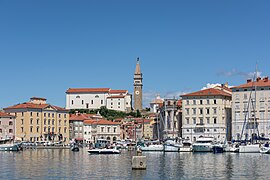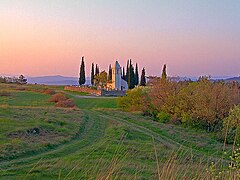Slovene Istria
Slovene Istria
Slovenska Istra (in Slovene) Istria slovena (in Italian) | |
|---|---|
UTC+02 (CEST ) |
Slovene Istria (Slovene: slovenska Istra; Italian: Istria slovena) is a region in southwest Slovenia. It comprises the northern part of the Istrian peninsula, and is part of the wider geographical-historical region known as the Slovene Littoral. Its largest urban center is Koper. Other large settlements are Izola, Piran, and Portorož. The entire region has around 120 settlements. In its coastal area, both Slovene and Italian are official languages.
The Slovene Riviera (Slovene: Slovenska obala) is located in Slovene Istria; both terms are sometimes used interchangeably, especially in the media,[citation needed] although Slovene Istria includes a wider geographical area.
History

The Istrian peninsula was known to
With the
In 952 King
Starting in 1267 the Republic of Venice gradually annexed the Istrian coast, also aided by the strong presence of the native Romance-speaking communities; the region regained its overseas ties which were loosened by the barbarian invasions. The coastal area somewhat reflowered, but the Venetian government's enmity toward Austria and the Ottoman Empire limited relations with the hinterland. After Napoleon's triumph in Padania, the Treaty of Campo Formio in 1797 gave most of the Venetian Republic and all of the peninsula to the Habsburgs.
Between 1805 and 1813, it was under French rule, first as part of the Napoleonic
After
Between the 1950s and 1970s, the region experienced profound changes. A significant portion of the rural population moved to the coastal towns, which remained semi-deserted after the Istrian–Dalmatian exodus. The local Italian population shrank in number. Many villages were depopulated, while the towns grew in number. Koper developed into an important portal town, and one of the major centres of Slovenian economy.
Geography
The 43 kilometers long
The most important water-flows in Slovenian Istria are the Dragonja and Rižana rivers.
-
Koper
-
Izola
-
Piran
-
Portorož
-
Rural landscape in Slovenian Istria
-
Moon Bay, Strunjan
-
Debeli Rtič Peninsula and Ankaran
-
A cruise ship in Koper harbour
Economy and transportation
Slovenian Istria is the second most prosperous region in Slovenia after
The Port of Koper is the only international port in Slovenia and one of the largest in the Adriatic Sea. It is considered[by whom?] as one of the strategically most important firms in Slovenian economy.
Tourism
Tourism is one of the main industries on the Slovenian coast, especially in
Agriculture
Slovenian Istria is especially renowned for its
.Language

In the
According to the 2002 census, Slovene is spoken as the first language by 70.2% of the inhabitants of Slovenian Istria, Italian by 3.3%, and various forms of Serbo-Croatian, dominated by Croatian, by 16% of the population. The highest percentage of Italian speakers is in the municipality of Piran (7%), while the highest percentage of Croatian speakers is in Izola (31%). General population polls have shown that the majority of the population in Slovenian Istria is conversational in several languages: Slovene, Italian, Croatian and English, all of which have at least some degree of presence in press, administration, business and popular culture.
Slovene-Italian bilingualism
Both Slovene and Italian are official in the municipalities of Piran, Izola and Koper. However, Italian is co-official only in the strip of land on the coast, traditionally inhabited by Istrian Italians. In the villages in the interior, only Slovene is official.[citation needed]
According to law, all official signs are to be written in both languages, as should all public notifications. Italian is to be used in all public offices in the bilingual area. For most jobs in the public administration and other public offices, the knowledge of both Slovene and Italian is required. Beside Slovene language schools, there are also elementary, high and grammar schools with Italian as the language of instruction. Pupils may choose between an education in Slovene or Italian; in either case, the other official language is being taught during the whole period of education, in order to provide that all residents speak both languages. At the state-owned University of Primorska, however, which is also established in the bilingual area, Slovene is the only language of instruction (although the official name of the university additionally includes the Italian version).
Italian may be used in the municipal assemblies of Koper, Izola and Piran, although in practice almost all discussions are carried out in Slovene.
Dialects
In the rural areas of Slovenian Istria, the
In the urban areas, a hybrid regional version of Slovene is spoken, which is phonetically very different from the rural dialects. It developed after World War Two, when new settlers from all Slovenia (many of whom from
Traditionally, the Istrian Italians living in Slovenian Istria have spoken the Venetian language, which is nowadays being increasingly replaced by standard Italian.









